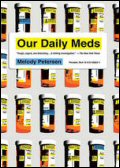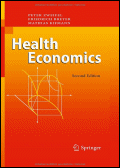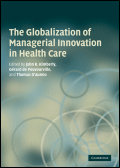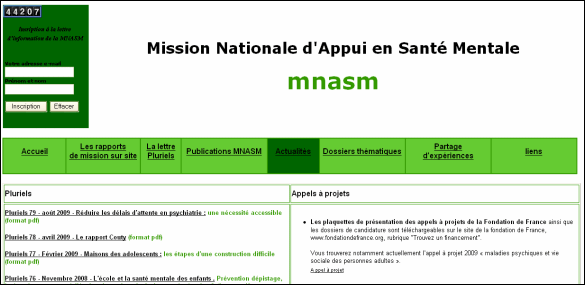LU POUR VOUS DE SEPTEMBRE 2009 : livres du mois - sites du mois - working papers
Tous les lu pour vous
LES LIVRES DU MOIS
Traité d'économie et de gestion de la santé.
Bras P.-L. / dir, Pouvourville G. de / dir, Tabuteau D. / dir
Paris : Editions de Santé ; Paris : SciencesPo Les Presses, 2009, Pages : 561 p.
Cet ouvrage collectif pluridisciplinaire placé sous la direction de Pierre-Louis Bras, Gérard de Pouvourville et Didier Tabuteau est composé de 59 chapitres ayant chacun un auteur spécialisé différent. Il s'agit à la fois d'un bel outil et d'une référence, le gold standard de la pensée et de l'analyse du système de santé actuel. Ce traité synthétise l'ensemble des problématiques et des connaissances de base pour comprendre les débats économiques sur la santé, il permet d'appréhender les politiques de régulation des dépenses de santé et constitue une aide à la gestion et au pilotage des principales institutions du système de santé. Destiné aux étudiants, aux décideurs et aux acteurs de la santé, il pourrait aussi fournir « quelques clés pour faire évoluer et conforter une organisation collective qui est au cœur du pacte social », comme le souhaitent les auteurs. Chacun peut en effet y trouver ce qu'il recherche dans le champ de l'économie et de la gestion de la santé dans les huit chapitres qui structurent l'ouvrage : principes généraux, les dépenses de santé, l'accès aux soins, la maîtrise des dépenses de santé, la qualité, la gouvernance et les acteurs, l'information de santé, mondialisation et santé. Aujourd'hui soigner et compter sont des notions admises par tous et ne sont plus antinomiques : cet ouvrage le démontre largement.
La santé des femmes en France.
Allonier C., Dourgnon P., Sermet C., Rochereau T. et al.
Collection Etudes et Statistiques. Paris : Drees, 2009, 285 p.
Publié par la Direction de la recherche, des études, de l'évaluation et des statistiques (DRESS, ce rapport, qui s'appuie sur un travail collectif de grande ampleur, présente les problèmes de santé touchant les femmes, par pathologie et par déterminant de santé. S'intéresser spécifiquement à la santé des femmes, c'est à la fois porter un regard sur les inégalités qui demeurent entre femmes et hommes et prendre en compte le clivage social grandissant au sein même de la population féminine. Cette double approche, sexuée et sociale, est mobilisée tout au long de cet ouvrage qui collige l'ensemble des données disponibles dans le champ sanitaire et social. Les auteurs – statisticiens, épidémiologistes, médecins, démographes, sociologues – ont réuni leurs compétences pour réaliser cette photographie de la santé des femmes en 2008. À partir de fiches thématiques conjuguant les approches par pathologie et par population, les problèmes de santé sont abordés en onze chapitres : données de cadrage, santé sexuelle et reproductive, périnatalité, maladies infectieuses, maladies chroniques et vieillissement, cancers, addictions et toxicomanie, santé mentale, accidents et traumatismes, santé et travail, santé et précarité. Un éclairage particulier est porté sur trois problématiques au cœur des préoccupations actuelles de santé publique : la périnatalité, la santé sexuelle et reproductive ainsi que les violences subies par les femmes. Une synthèse vient compléter ce panorama. Au-delà des constats, ce recueil se veut un outil d'aide à la décision afin de prévenir les changements dans l'organisation des soins au carrefour des secteurs sanitaire et social et met en lumière des besoins de connaissance importants.
Et si demain... la Sécurité sociale éclatait ?
Laxalt J.-M.
Paris ; Editions Jacob-Duvernet, 175 p.
Et si demain les choses évidentes disparaissaient, les institutions solides s'écroulaient, les habitudes bien ancrées s'évanouissaient. Et si demain la Sécurité sociale n'existait plus... Partant de ce postulat qui en inquiéterait plus d'un, Jean-Michel Laxalt, le président de la MGEN, fin connaisseur de l'univers de l'économie sociale, démonte la pelote de fils particulièrement enchevêtrés que constitue le système français de la protection sociale, le système le plus développé au monde. Il sait qu'il traverse une grave crise, (l'implosion est l'une des hypothèses !), il le dit, mais il affirme aussi que c'est pourtant le meilleur des systèmes, un modèle à la française qu'il veut défendre coûte que coûte.Au travers d'entretiens avec une dizaine d'experts d'horizons variés, Jean-Michel Laxalt pose des questions difficiles, en suscite d'autres, certaines volontairement iconoclastes : la Sécurité sociale a-t-elle laissé tomber les pauvres ? La modernité, c'est aujourd'hui sans la Sécu ? Dans une société atomisée, l'autre a-t-il moins l'importance ? En somme, la société française veut-elle continuer à vivre avec elle-même ? C'est la question défi de ce livre. En affichant un optimisme volontariste, Jean-Michel Laxalt répond positivement en voulant continuer à faire vivre ce système français de protection pour assurer la cohésion sociale de ce pays. La démarche du livre sera poursuivie par les travaux de l'Institut Montparnasse que vient de créer Jean-Michel Laxalt avec l'idée "d'exporter" le modèle français.
Guide pratique des lois du 2 janvier 2002 et du 4 mars 2002 : comparaison entre les droits des malades et les droits des usagers.
Pain-Masbrenier M.-T., Nicoleau P.
Bordeaux : Les Etudes Hospitalières, 2009, 271 p.
La loi n° 2002-2, du 2 janvier 2002, rénovant l'action sociale et médico-sociale, a transformé en profondeur les pratiques dans les établissements et services de ce secteur. De son côté la loi n ° 2002-303, du 4mars 2002, relative aux droits des malades et à la qualité du système de santé, a bouleversé le rôle de chacun à l'hôpital en instituant de nouveaux droits en faveur de la personne malade. Cette première étude comparée de ces deux textes fondamentaux apporte un éclairage neuf sur les pratiques dans les différents établissements concernés.
Lexique de sciences économiques et sociales.
Piriou J.-P.
Paris : La Découverte. 2007. 126 p.
La précision, l'ampleur, la clarté et la rigueur scientifique des quelques 1 400 entrées de ce lexique en font un instrument de travail aujourd'hui sans équivalent. Ce dictionnaire en petit format e poche regroupe de façon précise les termes sur lesquels l'économiste, apprenti ou chevronné, a besoin de précision. Les termes sociologiques ne soient pas sacrifiés.
Nos médicaments quotidiens.
Our daily meds.
Petersen M.
New York : Picador. 2009. 432 p.
Réalisé par un journaliste spécialisée dans le domaine des médicaments, cet ouvrage met en évidence le système de corruption mis en place par les grandes firmes pharmaceutiques américaines. En effet, trois scandales révélés en 2008 aux États-Unis ont attiré l'attention sur les relations incestueuses entre l'industrie pharmaceutique, la recherche universitaire et les instances chargées d'autoriser et de contrôler l'usage des médicaments. Plusieurs livres de qualité décrivent en détail la corruption du système de santé et de la recherche médicale. La plupart des médicaments mis sur le marché américain sont davantage le résultat d'une recherche en marketing que d'un investissement scientifique. Leurs vertus sont gonflées, les effets secondaires minimisés ou gommés. Une fois mis sur le marché, ils sont souvent détournés de leur indication initiale, afin d'être vendus en plus grande quantité. Des maladies nouvelles sont même inventées pour créer de nouveaux marchés.
La culture de notre mécontentement : au-delà du modèle médical de la maladie mentale.
The Culture of Our Discontent: Beyond the Medical Model of Mental Illness.
Small M.F.
Washington : Joseph Henry Press. 2006. 195 p.
By many estimations, the Western medical model of mental health is dangerously incomplete. If we step outside of the traditional disease model there are many new and different ways to understand, treat, and even accept mental illness. Culture--how we collectively live, interact, and view the world frames our mental outlook.
Economie de la santé.
Health Economics.
Zweifel P., Breyer F., Kiemann M.
Dordrecht : Heidelberg. 2009. 529 p.
The most thorough book available on the economics of health and health care delivery, Health Economics develops the theory necessary to examine these issues analytically and presents empirical evidence on each issue, summarizing results for easy comprehension. Issues discussed include the "cost explosion" in health care, the role of physicians and the power of medical associations, and the control of technological change in medicine. Because the level of sophistication is rapidly expanding in health economics, this book also provides key analytic tools required to understand research that is currently in progress.
La globalisation de l'innovation managériale en santé.
The globalization of managerial innovation in Health Care.
Cambridge : Cambridge University Press. 2008. 379 p.
In 1983, the first patient classification system to be used on a national basis, the Diagnosis Relate Groups (DRGs), was adopted as part of the Prospective Payment System in the United States. This system caught the attention of health policy makers in other countries, and a number of them began to implement similar approaches. What motivated them to adopt these systems? What similarities and differences were there among their experiences in implementing these systems? What can we learn about introducing change into national health systems by comparing their experiences? The Globalization of Managerial Innovation in Health Care answers these and other questions by examining patient classification systems in fifteen different countries throughout the world. The result is a remarkable collection of case studies of how change can be introduced effectively into national health systems as well as a careful synthesis of what can be learned from them.
LES SITES DU MOIS DE SEPTEMBRE
Ascodocpsy
www.ascodocpsy.org/
Presentation
Ascodocpsy est un réseau documentaire en santé mentale. Il a mis en ligne sur son site une base documentaire francophone en santé mentale « SantéPsy » de plus de 42 000 références d'articles de périodiques, de thèses et mémoires, de textes officiels et de rapports. Il propose les derniers textes officiels et les 10 dernières publications introduites dans sa rubrique « Veille ».
Centre de recherche Psychotropes, Santé mentale, Société – CESAMES
http://cesames.org/spip/
Presentation
Cette unité miste de recherche a comme projet d'étudier par les sciences sociales la santé mentale, domaine qui inclut la psychiatrie. Elle explore en particulier trois domaines d'investigation : la nébuleuse de la nouvelle prise en charge de la souffrance psychique, l'extension du domaine des drogues à celui des addictions ; et, à partir d'une réflexion plus épistémologique, de comprendre le sens de l'ouverture de la psychiatrie aux neurosciences. Le site présente les recherches en cours, la production scientifique des chercheurs, les séminaires et journées d'étude organisés par le CESAMES.
Mission Nationale d'Appui en Santé Mentale
http://www.mnasm.com/
Presentation
Mise en place en 1993 et confiée au Docteur Gérard Massé suite à la parution de son rapport " la psychiatrie ouverte, une dynamique nouvelle en santé mentale ", la Mission Nationale d'Appui en Santé Mentale (MNASM) est une instance de médiation et d'aide à l'évolution du dispositif de soins en santé mentale. Ses missions sont fixées et évaluées par un comité de pilotage, composé des Directeurs de la Direction de l'Hospitalisation et de l'Organisation des Soins, de la Direction Générale de l'Action Sociale, de la Direction Générale de la Santé, de la Caisse Nationale de Solidarité pour l'Autonomie et de représentants des ARH et des services déconcentrés de l'État (DDASS et DRASS). La MNASM propose des interventions sur sites, des expertises ponctuelles pour l'Administration centrale et des actions de communication et de formations pour faciliter l'accompagnement des acteurs. Son site propose en texte intégral, tous les rapports de mission sur site, une lettre d'information et d'échange « Pluriels », les rapports d'activités ainsi que des dossiers thématiques (textes officiels et rapports). Une rubrique « Partage d'expériences » permet la valorisation des actions de terrain qui vise à l'évolution et à la diversification de l'offre psychiatrique ainsi qu'à la coopération entre psychiatrie et différents partenaires.
Autres sites d'intérêt :
Psydoc France
http://psydoc-fr.broca.inserm.fr/
Santé mentale et dépendance aux substances
http://www.who.int/mental_health/en/
Santé Mentale Europe
http://www.mhe-sme.org/fr.html
Syndicat des psychiatres français / Association Française de Psychiatrie
http://www.psychiatrie-francaise.com/
VU DE L'ETRANGER : QUELQUES WORKING PAPERS ANALYSES
Assurance maladie
L'effet de l'assurance maladie privée sur l'utilisation des soins médicaux et sur l'état de santé autoévalué en Allemagne. 

The effect of private health insurance on medical care utilization and self-assessed health in Germany
Hullegie P., Klein T.J
York : HEDG 2009/07. 27 p.
In Germany, employees are generally obliged to participate in the public health insurance system, where coverage is universal, co-payments and deductables are moderate, and premia are based on income. However, they may buy private insurance instead if their income exceeds the compulsory insurance threshold. Here, premia are based on age and health, individuals may choose to what extent they are covered, and deductables and co-payments are common. In this paper we estimate the effect of private insurance coverage on the number of doctor visits and self-assessed health. Variation in income around the compulsory insurance threshold provides a natural experiment that we exploit to control for selection into private insurance. We document that income is measured with error and suggest an approach to take this into account. We find negative effects of private insurance coverage on the number of doctor visits and positive effects on health.
Economie de la santé
Qu'est-ce qui explique la variation des coûts de traitement dans les services d'obstétrique anglais ? 

What explains variation in the costs of treating patients in english obstetrics specialities ?
Laudicella M., Olsen K.M., Street A.
York : University of York 2009/07. 19 p.
We assess patients admitted to English obstetrics departments to identify what proportion of variation in their costs is explained by patient characteristics and what proportion is due to departmental characteristics. Hospital Episode Statistics records for every patient admitted to obstetrics departments are matched to Reference Cost data by HRG reported by all English hospitals for the year 2005/6. Our sample consists of 951,277 patients in 136 departments. We estimate fixed effects models analysing patient-level costs, explore departmental characteristics that drive variation in costs at department-level and explore the sensitivity of results to the use of the full sample and sub-samples of obstetrics patients. Patient costs depend on various diagnostic characteristics over and above the HRG classification, particularly whether the patient suffered infection. After controlling for patient characteristics a substantial amount of unexplained variation in costs remains at departmental level. Higher costs are evident in departments that are not supported by a neonatology specialty and where factor prices are higher. There is evidence of lower costs in departments with high volumes of activity. We identify departments where further scrutiny of their high costs is required.
Hôpital
La géographie des admissions à l'hôpital dans le service public de santé : données italiennes. 

The geography of hospital admission in a National Health Service with patient choice: Evidence from Italy
Fabbri D., Robone S.
York : HEDG. 2009/07. 32 p.
Every year 35% of the 10 million hospital admissions in Italy occurs outside the patients' Local Health Authority of residence. In this paper we look for explanation for this phenomenon and estimate gravity equations for "trade" in hospital care using a Poisson pseudo maximum likelihood method. Our results suggest that the gravity model is a good framework for explaining patient mobility in most of the examined diagnostic groups. We find that the ability to restrain the imports of hospital services increases with the size of the pool of enrollees. Moreover, the ability to export hospital services, as proxied by the ratio of export-to-internal demand, is U-shaped. Therefore our evidence suggests that there are scale effects played by the size of the pool of enrollees.
Inégalités devant les soins
Caractéristiques géographiques des besoins en soins non satisfaits en Italie. 

Geographical patterns of unmet health care needs in Italy.
Cavalieri M.
Munich : Munich Personal RepEc Archive. 2009/06. 26 p.
In recent years, health care reforms and restrained budgets have risen concerns about accessibility to health services, even in countries with universal coverage health systems. Previous studies have explored the issue by using objective event-oriented measures such as those related to utilization of health care. Analyzing access through subjective process-oriented indicators allows to better disentangle the process of seeking care, to investigate self-perceived barriers to health services and to account for differences in individual health care preferences. In this paper, data from the 2006 Italian component of the European Survey on Income and Living Conditions (EU-SILC) are used to explore reasons and predictors of self-reported unmet needs for specialist and/or dental care among adult Italians aged 18 and over. Results reveal different patterns across socio-economic groups and geographical macro-areas. Evidence of income-related inequalities and violations of the horizontal equity principle are also found both at a national and regional level. Policies to address unmet health care needs should adopt a multidimensional approach and be tailored so as to consider such heterogeneities.
L'impact de l'accessibilité sur l'utilisation des soins de spécialistes en Norvège. 

The impact of accessibility on the use of specialist health care in Norway.
Iversen T., Kopperud G.S
Oslo : HERO. 2002. 35 p.
What factors contribute to the utilization of specialist health care in Norway, and to what extent is the policy goal of allocating health care according to peoples medical need fulfilled? With this scope the authors analyse the impact of a person's health relative to the impact of access to specialist care. It is distinguished between services provided by public hospitals and services provided by private specialists financed by the National Insurance Scheme. The data allow to consider individual patient characteristics since Survey of Living Conditions data are merged with data on capacity and access to general practice and specialist care. The estimation of logit models and negative binomial models show significant differences between the factors that influence contacts with private specialists and contacts with hospitals. While a person's self-assessed health plays a major role in the utilization of hospitals, there is no significant effect of this variable on the utilization of private specialists. The supply-side variables measured by GP density and the accessibility indices for specialist care have significant effects on the utilization of private specialists, but not on hospital visits and inpatient stays. A preliminary conclusion is that the utilization of hospital services is rationed according to patients' health status, and not influenced by patients' access. Hence, the utilization of hospital services seems to be in accordance with officially stated health policy. On the other hand, private specialists seem to function as an alternative to general practice. Moreover, the significant effect of chronic conditions on the utilization of private specialists suggests that regular check-ups of chronic patients are an important part of the services provided by private specialists. The challenge to policy makers is to consider measures that bring the utilization of publicly funded private specialists in accordance with national health policy.
Médicaments
Compensations dynamiques des dépenses pharmaceutiques : analyse de données de panel. 

Dynamic Cost-offsets of Prescription Drug Expenditures: Panel Data Analysis Using a Copula-based Hurdle Model.
Deb P., Trivedi P.K., Zimmer D.M.
Cambridge : NBER. 2009/07. Pages : 40 p.
This paper presents a new multivariate copula-based modeling approach for analyzing cost-offsets between drug and nondrug expenditures. Estimates are based on panel data from the Medical Expenditure Panel Survey (MEPS) with quarterly measures of medical expenditures. The approach allows for nonlinear dynamic dependence between drug and nondrug expenditures as well as asymmetric contemporaneous dependence. The specification uses the standard hurdle model with two significant extensions. First, it is adapted to the bivariate case. Second, because the cost-offset hypothesis is inherently dynamic, the bivariate hurdle framework is extended to accommodate dynamic relationships between drug and nondrug spending. The econometric analysis is implemented for six different groups defined by specific health conditions. There is evidence of modest cost-offsets of expenditures on prescribed drugs.
Politiques relatives aux maladies orphelines et aux médicaments orphelins. 

Denis A., Simoens S., Fostier C., Megaert L.
Bruxelles : KCE 2009. 115 p.
Les objectifs de l'étude sont les suivants: fournir un aperçu des définitions communément utilisées pour les « maladies orphelines » et les « médicaments orphelins », ainsi que décrire les particularités des médicaments orphelins par rapport aux médicaments pour les maladies courantes ; Décrire les procédures réglementaires pour les médicaments orphelins, depuis la désignation orpheline jusqu'au remboursement ; comparer la politique belge en matière de remboursement des médicaments orphelins avec celle d'autres pays ; Estimer l'impact budgétaire actuel des médicaments orphelins et formuler une prévision de leur impact budgétaire dans le futur ; Formuler des recommandations à l'adresse des politiques sur les médicaments orphelins.
L'indicateur W.A.I.T pour les patients : phase 8 du rapport. 

Patients W.A.I.T. Indicator : Phase 8 report.
IMS Health
Bruxelles : EFPIA. 2007/11. 62 p.
In 2004, EFPIA commissioned IMS Health to produce a bi-annual study of delays between marketing authorization and effective patient access to new medicines in different EU Member States. The resulting "Patients' W.A.I.T. Indicator Report" (Waiting to Access Innovative Therapies) reveals substantial differences in patient access to new medicines across the European Union. The latest edition - the Patients' W.A.I.T. Indicator Phase 8 Report published in November 2007 - shows that, for 18 of the 20 European countries covered in the report, 20 to 94% of the medicines that received a marketing authorisation between 1 January 2003 and 31 December 2006 were still not available to patients on 30 June 2007.
Soins de santé primaires
Choisir un médecin généraliste. Expériences issues de la mise en place d'un système de liste d'attente en Norvège. 

Choosing a GP - Experiences from the implementation of a list patient system in Norway
Luras H.
Oslo : HERO. 2004. 35 p.
When the list patient system was introduced in Norway in 2001, the population was requested to choose a general practitioner (GP). Prior to the reform they were asked to rank their three most preferred GPs in an entry form. Information from the entry form was input for the algorithm that allocated GPs and inhabitants. The first aim of this paper is to explore what factors the Norwegian population considered to be important when they filled in the entry form and selected their preferred GP. We question whether they considered the GP's medical skill, practical matters or continuity of care, or if they felt that the opportunity set restricted their possibilities to make a choice. The second aim of the study is to identify factors of importance to the outcome of the allocation process. Important questions are whether the whole population participates in the list patient system, what factors characterize those who refuse to participate, and what factors that determine whether individuals' are allocated to their first-choice doctor. The third aim of the study is to identify factors of importance as to whether people express satisfaction with their GP after the reform. We question whether predisposing factors, prior illness or individuals' preferences matter, whether characteristics of the personal GP are of importance and finally, whether the outcome of the allocation process and the organization of the local health care market influence individuals' satisfaction with their GP.
Copaiement des visites médicales en Allemagne et la probabilité de consulter un médecin - résultat d'une expérimentation. 

Copayments for doctor visits in Germany and the probability of visiting a physician - Evidence from a natural experiment.
Farbmacher H.
Munich : university of Munich. 2009. 16p.
The German health care reform of 2004 imposes a charge of 10 Euro for the first visit to a doctor in each quarter of the year. At first glance, there is no inhibiting effect of this fee on utilization in the German Socio-Economic Panel. However, this study reveals that the true effect is diluted by a special characteristic of the fee. Exploiting random variation in the interview date, this study finds a substantial effect of the new fee on the probability of visiting a physician. In addition, the identification strategy makes it possible to disentangle this effect from the influence of the contemporaneous increase of copayments for prescription drugs.
Systèmes de santé étrangers
Etude de l'OCDE sur le système de santé en Turquie. 

OECD Reviews of Health Systems : Turquie.
Paris : OCDE. 2009/02. 141 p.
This comprehensive review of Turkey's health care system shows that health status has improved rapidly in Turkey in recent decades, partly as a result of higher health spending. It describes the introduction of an ambitious Health Transformation Programme in 2003 which brought universal health insurance to Turkey in 2008 and has begun the process of public hospital reforms and the rolling out of family-practitioner services throughout the country. Challenges remain, however, including completing the Health Transformation Programme and ensuring that the new health system provides value for money and stays affordable. This report analyses these challenges and sets out policy suggestions aimed at addressing them.
Une mesure à valeur ajouté de la production du système de santé et l'estimation de l'efficience des systèmes de santé des pays de l'OCDE. 

A Value-Added Based Measure of Health System Output and Estimating the Efficiency of OECD Health Systems.
Discussion Paper; 2009. 38 p.
Life expectancy at birth is the most commonly used measure for health system output. However, there are a number of reasons why it may be a poor proxy. First, life expectancy assumes a stationary population and thus does not take into account the current demographic structure of a country; and second, the output of a health system should be measured in terms of the value-added to the population's health status rather than health status itself. The paper develops a new measure of health system output, the Incremental Life Years to address these problems. The new measure is applied to study health system output, efficiency and total factor productivity in OECD countries for the years 2000 and 2004. The new measure provides different results compared to those based on the traditional life expectancy measure, and the differences are further accentuated when changes in efficiency and productivity are estimated.
Améliorer les incitations dans le programme du Medicare : rapport au Congrès. 

Improving incentives in the Medicare Program : report to the Congress.
Washington : MEDPAC. 2009/06. 277 p.
Recent studies show that the U.S. health care system is not buying enough recommended care and is buying too much unnecessary care, much of it at very high prices, resulting in a system that costs significantly more per capita than in any other country. These facts strongly indicate that our health care system is not delivering value for its stakeholders. As a major payer, the Medicare program shares in these problems. For decades, researchers have documented the wide variation across the United States in Medicare spending and rates of service use. For example, they find that rates of use for certain kinds of care, referred to as supply-sensitive services (i.e., likely driven by a geographic area's supply of specialists and technology), differ greatly from one region to another. The higher rates of use are often not associated with better outcomes or quality and instead suggest inefficiencies. One recent analysis shows that, at the state level, no relationship exists between health care spending per capita and mortality amenable to medical care, that an inverse relationship exists between spending and rankings on quality of care, and that spending is highly correlated with both preventable hospitalizations and hospitalizations for ambulatory-care-sensitive conditions. These findings point to inefficient spending patterns that result in poor value for our health care dollars. At the same time, they point to opportunities for improvement. In this report, the Commission discusses a number of issues and challenges for Medicare payment and delivery system reform. The issues range broadly but focus on how incentives in the current Medicare payment systems could be changed to reward value not volume.
Vieillissement
Les systèmes de retraites doivent-ils reconnaître les emplois à risque et la pénibilité du travail ? 

Should pensions systems recognize hazardous and arduous work ?
Zaidi A., Whitehouse E.
Paris : OCDE. 2009. 47 p.
Les régimes de retraite spéciaux pour les professions dangereuses ou pénibles existent de longue date. Depuis quelques temps, ils suscitent de multiples débats dans de nombreux pays de l'OCDE. Ces régimes ont pour origine l'idée selon laquelle les personnes qui exercent un métier dangereux ou pénible, l'exploitation minière souterraine par exemple, méritent un traitement particulier. Cette idée se justifie par le fait que ces métiers augmentent la mortalité et diminuent l'espérance de vie, réduisant ainsi la période pendant laquelle les personnes qui les exercent peuvent profiter de leurs prestations de retraite. C'est pourquoi elles ont le droit de partir à la retraite avant l'échéance fixée par le régime de retraite général national. Le présent rapport analyse l'incidence, la structure et la justification de ces régimes de retraite spéciaux dans les pays de l'OCDE. Il énumère les professions couvertes par ces régimes, et décrit les différentes sortes de privilèges existants. Il présente également une évaluation quantitative du patrimoine retraite supplémentaire auquel ont droit les travailleurs relevant des régimes spéciaux. Les conclusions formulées en fin de document s'accompagnent d'une description des réformes récemment mises en place dans certains pays de l'OCDE. Le rapport examine à la fois les problèmes pratiques et conceptuels que présentent ces régimes spéciaux, et fournit ainsi une synthèse générale des principales considérations concernant ces questions. Plusieurs conclusions d'ordre général peuvent être dégagées de l'exposé qu'il contient. Ces régimes spéciaux ne se justifient que pour des groupes étroitement définis qui restent confrontés au risque de mortalité prématurée en raison de la dangerosité ou de la pénibilité de leurs conditions de travail. Il n'en demeure pas moins que les arguments à l'appui du maintien ou de l'instauration de régimes de retraite spéciaux pour les personnes exerçant des métiers dangereux ou pénibles sont faibles. Leur maintien tient davantage à la résistance institutionnelle à leur réforme qu'à leur utilité en tant que régime public de retraite complémentaire. Par ailleurs, quand les risques pour la santé des personnes exerçant ses métiers sont avérés, des politiques sociales classiques bien ciblées, telles que les prestations chômage (avec obligation de recherche d'emploi), les pensions d'invalidité ou les prestations de maladie professionnelle permettent de traiter plus efficacement chaque cas sur une base individuelle. Si la retraite anticipée doit être maintenue pour certains métiers ou professions, elle devrait être financée par les cotisations patronales et salariales.











